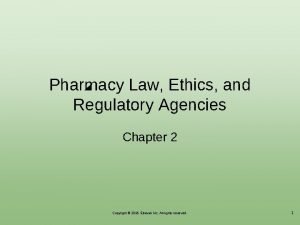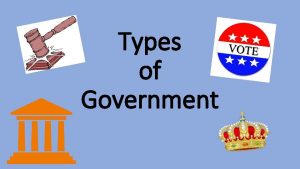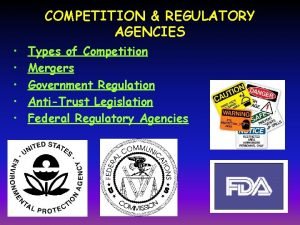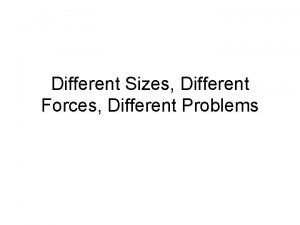Different government regulatory agencies Regulatory agencies in the





















- Slides: 21

Different government regulatory agencies Regulatory agencies in the USA and EU 17. 2. 1 List different government regulatory agencies and describe them Unit C 17. 2 Intro to Medical Equipment Regulation Module 279 -17 -C Regulations, Standards and Ethics dr. Chris R. Mol, BME, NORTEC, 2015

Government tasks (? ) Collect Taxes • income tax • property tax • inheritance tax • sales tax • …. Provide Subsidies • Fuel • Maize • …. Establish Laws & Regulations • fair competition Provide Public Safety • police, army • food regulations • medical equipment safety Provide Public Utilities • water • electricity • sewage • telephone Provide Public Transport • bus • train • airplane Provide Public Infrastructure • roads • government buildings © dr. Chris R. Mol, BME, NORTEC, 2015 Education • primary schools • secondary schools • colleges • universities Healthcare • hospitals • health programs Businesses • copper mines • hydro dams • maize seeds & sales Government Regulatory Agencies

Cost of Regulations All regulations impose a cost on society (manufacturers, vendors, users, public, government) to establish and maintain such regulations. It is important that the cost of regulations is • not higher than necessary and • justified by the (public) benefits © dr. Chris R. Mol, BME, NORTEC, 2015 Government Regulatory Agencies

FDA / USA © dr. Chris R. Mol, BME, NORTEC, 2015 Government Regulatory Agencies

FDA: the Food and Drug Administration The Food and Drug Administration (FDA) is a federal agency of the United States Department of Health and Human Services. The FDA is responsible for protecting and promoting public health through the regulation and supervision of: • food safety, tobacco products, dietary supplements, prescription and over-the-counter pharmaceutical drugs (medications), vaccines, biopharmaceuticals, blood transfusions, medical devices, electromagnetic radiation emitting devices (ERED), cosmetics, animal foods & feed and veterinary products. The agency has 223 field offices and 13 laboratories located throughout the United States. In 2008, the FDA began to post employees to foreign countries, including China, India, Costa Rica, Chile, Belgium, and the United Kingdom. In 2010, the FDA had 15, 100 employees. © dr. Chris R. Mol, BME, NORTEC, 2015 Government Regulatory Agencies

FDA: the Food and Drug Administration The FDA regulates more than US$1 trillion worth of consumer goods, about 25% of consumer expenditures in the United States. This includes $466 billion in food sales, $275 billion in drugs, $60 billion in cosmetics and $18 billion in vitamin supplements. Much of these expenditures are for goods imported into the United States; the FDA is responsible for monitoring imports. The FDA's federal budget request for fiscal year (FY) 2012 totalled $4. 4 billion. About $2 billion of this budget is generated by user fees. Pharmaceutical firms pay the majority of these fees, which are used to expedite drug reviews. © dr. Chris R. Mol, BME, NORTEC, 2015 Government Regulatory Agencies

FDA: the Center for Devices and Radiological Health The Center for Devices and Radiological Health (CDRH) is the branch of the FDA responsible for • regulating firms who manufacture, repackage, relabel, and/or import medical devices sold in the United States. • the pre-market approval of all medical devices, as well as overseeing the manufacturing, performance and safety of these devices. In addition, CDRH regulates radiation-emitting electronic products (medical and non-medical) such as lasers, x-ray systems, ultrasound equipment, microwave ovens and color televisions. CDRH regulatory powers include the authority: • to require certain technical reports from the manufacturers or importers of regulated products, • to declare regulated products defective, and • to order the recall of defective or noncompliant products. CDRH also conducts limited amounts of direct product testing. © dr. Chris R. Mol, BME, NORTEC, 2015 Government Regulatory Agencies

FDA: General Controls General controls are the minimum regulations that apply to all FDA regulated medical devices. © dr. Chris R. Mol, BME, NORTEC, 2015 Government Regulatory Agencies

FDA: General Controls General controls include the next five elements: 1. 2. 3. 4. 5. © establishment registration — for e. g. manufacturers, distributors and foreign firms device listing — listing with FDA of all devices to be marketed; good manufacturing practices (GMP)—manufacturing of devices in accordance with the Quality Systems Regulation (QSR) labelling — labelling of devices or in vitro diagnostic products; premarket notification — submission to FDA of a premarket notification 510(k). dr. Chris R. Mol, BME, NORTEC, 2015 Government Regulatory Agencies

EU © dr. Chris R. Mol, BME, NORTEC, 2015 Government Regulatory Agencies

EU Legal Framework The EU aims to remove technical barriers to trade and dispel the consequent uncertainty for economic operators, to facilitate free movement of goods inside the EU. The core legal framework related to medical devices consists of three directives: • Directive 90/385/EEC regarding active implantable medical devices • Directive 93/42/EEC regarding medical devices • Directive 98/79/EC regarding in vitro diagnostic medical devices The Medical Device Directive 93/42/EEC of 14 June 1993 concerning medical devices, is intended to harmonise the laws relating to medical devices within the European Union. The Directive was most recently reviewed and amended by the 2007/47/EC and a number of changes were made. Compliance with the revised directive became mandatory on March 21, 2010 © dr. Chris R. Mol, BME, NORTEC, 2015 Government Regulatory Agencies

There a lot of Regulations in the EU … © dr. Chris R. Mol, BME, NORTEC, 2015 Government Regulatory Agencies

EU: Competent Authority The government of each Member State must appoint a competent authority (CA) responsible for medical devices. The competent authority is a body with authority to act on behalf of the member state to ensure that member state government transposes requirements of medical device directives into national law and applies them. The CA reports to the minister of health in the member state. In the UK, for example, the Medicines and Healthcare products Regulatory Agency (MHRA) acts as a CA The Regulatory Agencies of the EU countries all have to comply with EU Directives… © dr. Chris R. Mol, BME, NORTEC, 2015 Government Regulatory Agencies

EU: Declaration of Conformity The authorization of medical devices is guaranteed by a Declaration of Conformity. This declaration is issued by the manufacturer itself. • Medical devices that fit in class I can be marketed purely by self-certification. • For products in higher classes, it must be verified by a Certificate of Conformity issued by a Notified Body. A Notified Body is a public or private organisation that has been accredited to validate the compliance of the device to the European Directive. All certified medical devices should have the CE mark on the packaging, insert leaflets, etc. © dr. Chris R. Mol, BME, NORTEC, 2015 Government Regulatory Agencies

The CE mark is a conformity mark which all European medical devices must have before they can be marketed. It is seen as a declaration by the manufacturer that the product meets all the appropriate provisions of the relevant legislation including those related to safety and, where required, has been assessed in accordance with these. The CE marking of conformity must appear in a visible, legible and indelible form on the device or its sterile pack, where practicable and appropriate, and on the instructions for use. Where applicable, the CE marking must also appear on the sales packaging. It shall be accompanied by the identification number of the notified body involved. The initials “CE” do not stand for any specific words; it is a symbol that is seen as a declaration by the manufacturer that the product meets all the appropriate provisions of the relevant legislation. © dr. Chris R. Mol, BME, NORTEC, 2015 Government Regulatory Agencies

EU: Essential Principles applicable to all Medical Devices A 1 Medical devices should be designed and manufactured in such a way that, when used under the conditions and for the purposes intended and, where applicable, by virtue of the technical knowledge, experience, education or training, and the medical and physical conditions of intended users, they will perform as intended by the manufacturer and not compromise the clinical condition or the safety of patients, or the safety and health of users or, where applicable, other persons, provided that any risks which may be associated with their use constitute acceptable risks when weighed against the benefits to the patient and are compatible with a high level of protection of health and safety. © dr. Chris R. Mol, BME, NORTEC, 2015 Government Regulatory Agencies

EU: Essential Principles applicable to all Medical Devices A 2 The solutions adopted by the manufacturer for the design and manufacture of the devices should conform to safety principles, taking account of the generally acknowledged state of the art. When risk reduction is required, the manufacturer should control the risks so that the residual risk associated with each hazard is judged acceptable. The manufacturer should apply the following principles in the priority order listed: • identify known or foreseeable hazards and estimate the associated risks arising from the intended use and foreseeable misuse; • eliminate risks as far as reasonably practicable through inherently safe design and manufacture; • reduce as far as reasonably practicable the remaining risks by taking adequate protection measures, including alarms; and • inform users of any residual risks. © dr. Chris R. Mol, BME, NORTEC, 2015 Government Regulatory Agencies

EU: Essential Principles applicable to all Medical Devices A 3 Medical devices should achieve the performance intended by the manufacturer and be designed and manufactured in such a way that, during normal conditions of use, they are suitable for their intended purpose. A 4 The characteristics and performances referred to in Clauses A 1, A 2 and A 3 should not be adversely affected to such a degree that the health or safety of the patient or the user and, where applicable, of other persons are compromised during the lifetime of the device, as indicated by the manufacturer, when the device is subjected to the stresses which can occur during normal conditions of use and has been properly maintained in accordance with the manufacturer’s instructions. © dr. Chris R. Mol, BME, NORTEC, 2015 Government Regulatory Agencies

EU: Essential Principles applicable to all Medical Devices A 5 Medical devices should be designed, manufactured and packaged in such a way that their characteristics and performances during their intended use will not be adversely affected by transport and storage conditions (for example, fluctuations of temperature and humidity) taking account of the instructions and information provided by the manufacturer A 6 All known and foreseeable risks, and any undesirable effects, should be minimised and be acceptable when weighed against the benefits of the intended performance of medical devices during normal conditions of use. © dr. Chris R. Mol, BME, NORTEC, 2015 Government Regulatory Agencies

International Harmonization of Regulations Medical devices are used worldwide. With the rapid growth in the global market for medical devices, there is a need to harmonize national standards in order to minimize regulatory barriers, facilitate trade and improve access to new technologies. Harmonization also reduces the cost of implementing regulations for governments and local industry. We will return to the topic of Harmonization in section 17. 3 © dr. Chris R. Mol, BME, NORTEC, 2015 Government Regulatory Agencies

END The creation of this presentation was supported by a grant from THET: see https: //www. thet. org/
 Chapter 22 regulatory and advisory agencies
Chapter 22 regulatory and advisory agencies Regulatory agencies
Regulatory agencies Dea number verification
Dea number verification Universal precautions milady
Universal precautions milady National institute for food and drug surveillance
National institute for food and drug surveillance National powers
National powers Types of monarchy government
Types of monarchy government Forms of government
Forms of government Different forms of government
Different forms of government Brazil form of government
Brazil form of government Different forms of government
Different forms of government Name the different types of government
Name the different types of government Sound will travel at different speeds in different mediums.
Sound will travel at different speeds in different mediums. Different materials have different
Different materials have different What is cultural relativism
What is cultural relativism What things make us special
What things make us special Why do different polymers have different properties?
Why do different polymers have different properties? Different angle different story
Different angle different story Venn diagram different same different
Venn diagram different same different Flame test principle
Flame test principle Acids and bases song lyrics
Acids and bases song lyrics Library thinkquest org 19537
Library thinkquest org 19537









































